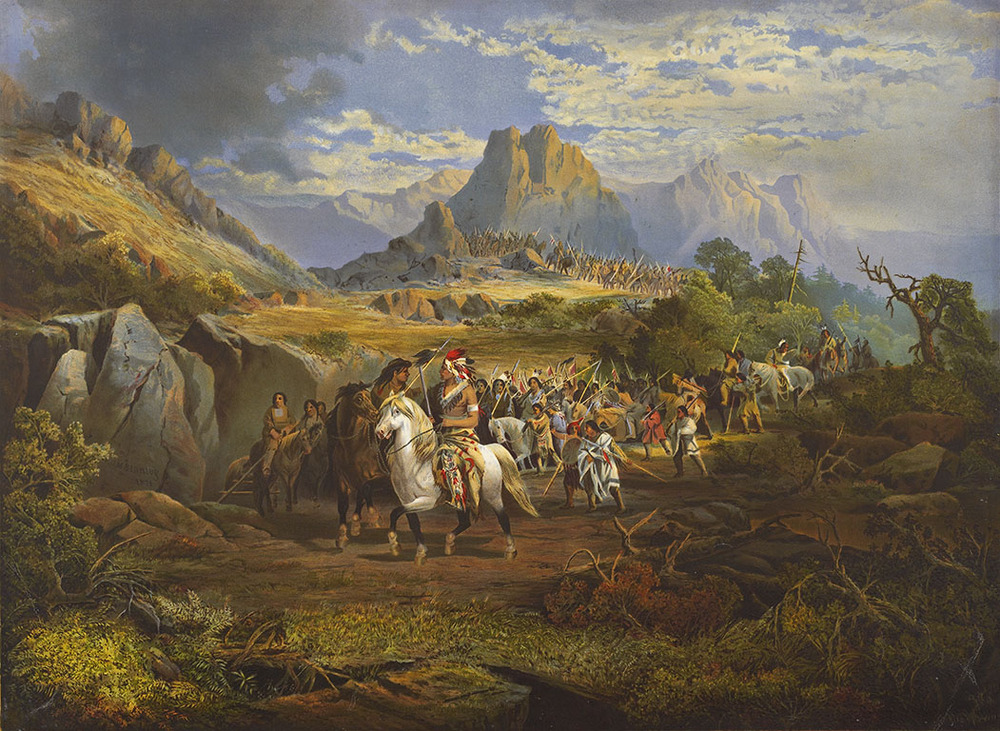Historical Background, John Mix Stanley Era
Especially pertinent to both 19th century American as well as John Mix Stanley’s life were the fading role that Native Americans played alongside the aggressive American westward expansion. These influences can be observed working in tandem within Stanley’s Mount Hood from the Dalles.
Stanley was born in New York in 1814 after the recent territorial expansion of the Louisiana Purchase of 1803 and the war of 1812 in which the United States attempted to expand northward into British Canada. This period in the 19th century planted the seeds for the globally dominant role that the United States of America was soon to play. Reflecting on this changing role, in the book titled Painted Journeys: The Art of John Mix Stanley, writer Peter Hassrick stated that, “His [Stanley] range of stylistic approaches and genres of art making bear the influence of his own peripatetic life, and the dissemination of his objects reveals his attempts to capitalize on interest in the West during a heightened period of expansion.” Stanley was able to combine his interest in Native Americans in conjunction with portrayals of the new western frontier in order to make a living as an artist.
It was suggested that Stanley’s interest in Native Americans may have come from his early encounters with the Iroquois tribe of New York. Additionally, George Caitlin’s successful 1830’s Indian gallery likely gave Stanley ideas for work in the future as well. Stanley grew up with these influences, as in the year 1830, the brutal Indian Removal Act was passed by the US congress. This policy, enforced by president Andrew Jackson, led to the deaths of thousands of Native Americans who refused to acknowledge the United States’ newly established borders with the Trail of Tears. In the mid 19th century, the portrayal of the apparent vanishing race of the Native Americans became a more lucrative venture as the much of the American public was fascinated by the exoticness and soon rarity of the Native Americans. Stanley’s lifelong obsession with Native American life was likely created from his exposure to the horrid mistreatment of Native Americans from his early childhood.
After this period of aggressive expansion, the country began to turn on itself with the infamous US civil war. Many artists played roles in depicting or using influences from the civil war, and Stanley was of no exception. The contemporary writer Peter Hassrick commented on the civil war’s effect on Stanley, “With his malleable entrepreneurial strategies, he exemplifies the shifting relationship between art, spectacle, and mass culture just before and and following the Civil War.” Just as Stanley was able to monetize the westward expansion, he too used the politically relevant civil war as a means for depicting the event in its entirety.
Following the war, and during the reconstruction era, Stanley painted Mount Hood from the Dalles. The dramatic events of the 19th century left a profound mark on his work that could be gleaned from his artistic choice made for the painting, such as the scale of the landscape relative to the Native American inhabitants.
1 Comment
— by Bennett Louis Stein (April 16 2018 @ 8:38 pm)
0 Tags & 0 Keywords
Tags
Created For
K-12 EducatorK-12 Student
Museum Visitor
UMMA Docent
UMMA Staff
University Faculty
University Student
Rate this Resource
AVG: 0 | Ratings: 0
& Author Notes
All Rights Reserved (The Era of Good Feelings and the Two-Party System. (n.d.). Retrieved March 28, 2018, from http://www.ushistory.org/us/23a.asp
This source was used for the political background of America throughout the mid 19th century.
www.ushistory.org/us/23a.asphttps://americanart.si.edu/art/highlights/19th-century.
This source gave me information on the art history portion that likely influenced our artist’s, John Mix Stanley, work.
(n.d.). Retrieved March 28, 2018, from http://www.csun.edu/~ta3584/Cole.htm
This source gave me the quote that I used from Thomas Cole from his writings (this was also an assigned reading from a previous week).
Painted journeys: The art of John Mix Stanley. (2015). 53(05). doi:10.5860/choice.194075
This source provided me with basic information, quotes, as well as how the painting was passed down through family until it reached the UMMA.
)
Last Updated
April 16, 2018 8:42 p.m.Report
Reporting Policy

